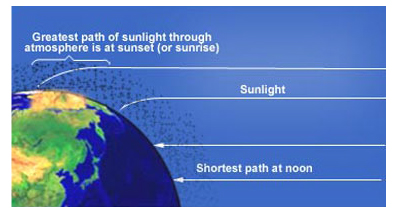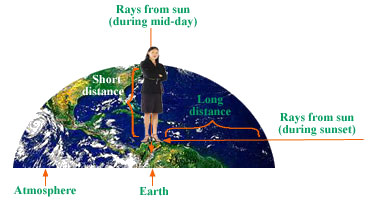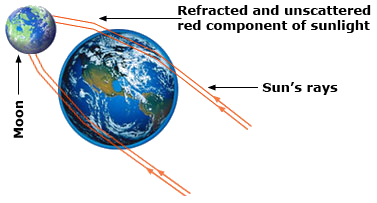Why sunsets (or sunrises) are red?


Light that isn't scattered is light that is transmitted. Because red, orange, and yellow light are the least scattered by the atmosphere, light of these lower frequencies is better transmitted through the air. Red, which is scattered the least, and therefore, transmitted the most, passes through more atmosphere than any other color. So the thicker the atmosphere through which a beam of sunlight travels, the more time there is to scatter all the higher-frequency components of the light. This means the light that best makes it through is red. As the below figure shows, sunlight travels through more atmosphere at sunset, and that is why sunsets (and sunrises) are red.
A sunbeam must travel through more atmosphere at sunset than at noon. As a result, more blue is scattered from the beam at sunset than at noon. By the time a beam of initially white light gets to the ground, only light of the lower frequencies survives to produce a red sunset (a red sunrise).
At noon sunlight travels through the least amount of atmosphere to reach the Earth's surface. Only a small amount of high-frequency light is scattered from the sunlight, enough to make the sun look yellowish.
As the day progresses and the sun drops lower in the sky, the path through the atmosphere is longer, and more violet and blue are scattered from the sunlight. The removal of violet and blue leaves the transmitted light redder. The sun becomes progressively redder, going from yellow to orange and finally to a red-orange at sunset. Sunsets and sunrises are unusually colorful following volcanic eruptions, because particles larger than atmospheric molecules are then more abundant in the air.
The colors of the sunset are consistent with our rules for color mixing. When blue is subtracted from white light, the complementary color that is left is yellow. When higher-frequency violet is subtracted, the resulting complementary color is orange. When medium-frequency green is subtracted, magenta is left. The combinations of resulting colors vary with atmospheric conditions, which change from day to day and give us a variety of sunsets to enjoy.
Now you can understand why the sun takes different hues during daytime!
Why does the Moon look red during lunar eclipse?


The moon looks yellow for the same reason as why the sun looks yellow. But the moon does look white sometimes. As you know moon reflects sun's rays. The reflection of the sunlight by rocks and mountains on the moon is as yet not understood clearly. It is presumed that these features alter the components of the reflected sunlight in such a way that when these rays reach our eyes, the moon looks white to us.
During a lunar eclipse, the shadow of the earth falls on the moon. Actually the moon should look black or in fact not be seen at all!! But it looks red in colour!
The reason for this is same as that of why the sun appears red during sunrise and sunset. The red part of the sunlight coming from behind the earth can pass unscattered and refracted through the Earth's atmosphere and reach the moon. This makes the moon look red during a lunar eclipse.
Why do colours look dull in moonlight?
The fact that objects illuminated with moonlight seem to lack color has to do with the way that your eyes perceive color.
The retina of the human eye, where the image is formed contains two types of light-sensitive cells: Cones and rods. The rods are all of the same type, and all they can do is detect the intensity of the light. They have nothing to do with color perception. The cones are three in kind, each sensitive to a green, blue and red.
While the rods can only sense intensity and are unable to detect colors, they can operate at very, very low intensities of light. The cones, while able to tell colors apart, need quite high intensities of light to actually detect anything.
Thus there is no perception of colors when there is very little light, as in the case of moonlit outdoors. This is because your cones can not operate, and all your brain receives is signals from the rods. Hence, the black and white visions.